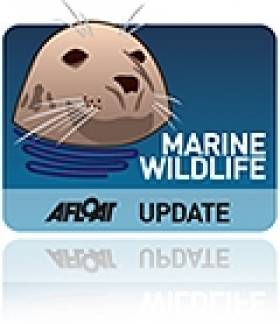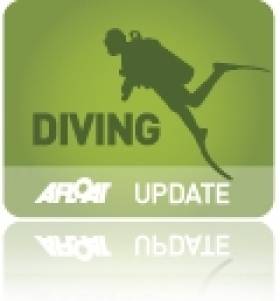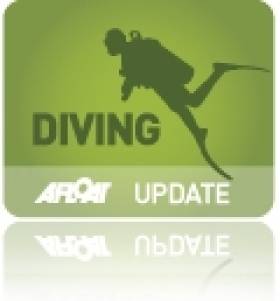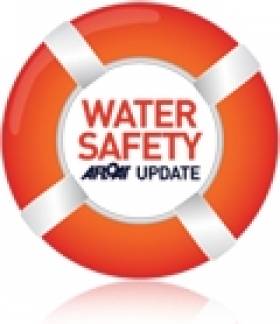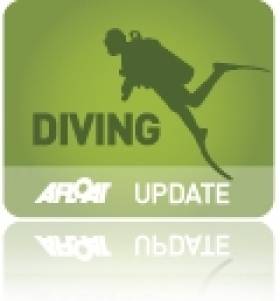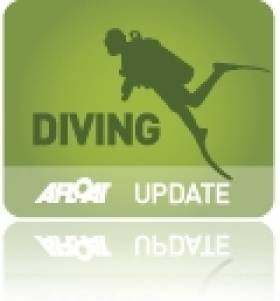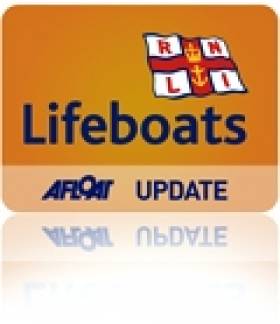Displaying items by tag: diving
Carlow's A Lock For Ireland's Premier Diving School
#Diving - A giant glass-sided water tank will be a feature of the new diver training facility that's currently under construction at Webster's Lock in Carlow town, as the Carlow Nationalist reports.
The new diving school on the River Barrow will be the new permanent home of the Carlow/Graiguecullen Sub Aqua Club and has been more than three years in the making.
According to the Irish Independent, phase one of the project is set to be completed by the New Year, and will see the old lock house transformed into a state-of-the-art training facility, with the glass-sided tank allowing trainees to watch divers in action from a viewing gallery.
When completed, the scheme will also include special lighting to facilitate night dive training, copious storage space and a compression zone.
It's hoped that the new centre will facilitate year-round training for divers across Ireland, both recreational divers and those aspirating for professional certification - the latter invaluable when volunteer divers are required for search and rescue efforts.
The Carlow Nationalist has more on the story HERE.
Diver Stung In Face By Jellyfish Off Skerries
#Jellyfish - In less welcome jellyfish news, the Irish Independent reports that a female diver was airlifted to hospital after being stung in the face by a jellyfish off Skerries at the weekend.
The injured woman had been diving yesterday morning (1 September) in shallow waters off the North Co Dublin town with a party of five, three of whom raised the alarm when they lost sight of the other two.
Skerries RNLI were requested to launch by the Dublin Coast Guard, and after a short time searching they located the missing divers on the shore at a local swimming spot called the Springers.
The lifeboat crew found one of the women was in need of urgent medical assistance, suffering from severe hypothermia and jellyfish stings to the face.
Medical transfer to Our Lady of Lourdes Hospital in Drogheda was decided as the best option, and the casualty was soon airlifted from nearby Red Island on board the Irish Coast Guard helicopter Rescue 116.
Speaking after the call-out, Skerries RNLI volunteer lifeboat press officer Gerry Canning said: "This was a perfect example of how well our volunteers and all the other emergency services work together to ensure that casualties get the best possible care and in the quickest possible time."
Diver Death Off East Anglian Coast
#Diving - The Guardian reports that British police are investigating the death of a diver off the coast of East Anglia yesterday (30 August).
The deceased was one of two divers from a group of seven who got into difficulty off Lowestoft in Suffolk during a recreational diving trip.
The other diver was taken to hospital but police said he was likely to be discharged.
A police spokesperson added that the dead man is not thought to be local, and that the authorities are trying to trace his next of kin.
The death is currently being treated as unexplained until a portmortem can take place.
British And NI Divers Called To Take Part In RNLI Survey
#Diving - Divers across Britain and Northern Ireland are being called on to help the RNLI with research into participation and attitudes to safety in the sport by taking part in a new online survey.
The RNLI, in partnership with the British Diving Safety Group (BDSG), is asking divers and dive instructors in the UK to take 10 minutes to complete the online survey, which looks at their reasons for participating in diving, how often they take to the water, preferred methods and locations, experience and training, awareness of possible hazards and use of safety measures.
The findings will be used to help the RNLI and BDSG develop tailored and relevant safety messages for the diving community, to help make the sport even safer.
Last year alone, 314 diving incidents were reported to the British Sub-Aqua Club (BSAC). The survey, being undertaken by Substance on behalf of the RNLI, launched on Tuesday 27 August and will run for nine weeks, during which time anyone who dives in the UK – no matter how often or what level of experience – is invited to take part.
To supplement the online survey, face-to-face surveys will be conducted at dive sites, charter boat launch and departure points, and at Dive 2013, the NEC Dive Show in October. In-depth interviews and focus groups will also be conducted. Divers wishing to take part in these are encouraged to contact Substance via the survey website.
RNLI coastal safety manager Nick Fecher, who is running the project, explained the reasoning behind the research.
"Diving is a hugely popular sport but accidents do happen. A total of 314 diving incidents were reported to BSAC last year and the RNLI’s volunteer lifeboat crews have rescued 96 divers and saved 13 divers’ lives in the past five years," he said.
"By carrying out this research, we hope to understand more about how and why people dive, what they know about the risks and what safety measures they take. We’re hoping to hear from divers of all levels of experience, so we can then develop really targeted and relevant safety advice to help them enjoy their sport as safely as possible.
"Coastal safety is a key part of the RNLI’s remit of saving lives at sea – by offering important safety advice to people taking part in coastal activities like diving, we hope to prevent incidents from happening in the first place and, ultimately, save lives."
All who participate in the survey are offered the option of free entry into a prize draw, with the first prize of a DX dive computer, kindly donated by Suunto Diving UK, and a second prize of an Abyss 22 regulator, kindly donated by Mares. Winners will be chosen by Substance using a random number generator by 15 November.
Rugby Star's Cousin Knocked Out In Diving Accident
#WaterSafety - Herald.ie reports that a young cousin of rugby international Jonny Sexton was "shocked but recovering well" after she was knocked out in a diving accident last week.
Fourteen-year-old Kelly Sexton was diving with friends off a 50-foot ledge at Diamond Rocks in Kilkee, Co Clare to celebrate her birthday when she apparently struck the water at an angle that rendered her unconscious.
Thankfully her friends came to her aid immediately and cared for her until she was airlifted to University Hospital Limerick by the Shannon coastguard rescue helicopter.
The incident came on the last weekend of the nationwide heatwave that saw a shocking 10 drownings around the island of Ireland.
Galway Diver Survives Conger Eel Attack
#CongerEel - A Galway businessman had a life-threatening encounter with a conger eel while SCUBA diving in Connemara last month, as the Connacht Tribune reports.
Jimmy Griffin, who owns Griffins Bakery on Galway's Shop Street, describes the wildlife attack as like being "hit by a freight train".
He continued: "It had me by the face and I was being tossed around like a rag doll. It hit my head really hard. My regulator was knocked out of my mouth.
"I knew something was after hitting me and biting me, but I didn’t know what it was. I couldn’t get my hands around it, it was so big. I managed to wrestle it off and the pain started to set in on my face.”
The pain was from a serious bite to the side of his mouth that would have sent a less experienced diver into a dangerous panic.
The Connacht Tribune has much more on the story HERE.
#Diving - An Irishman who set a world record for long-distance SCUBA diving is preparing to double that incredible feat.
Christopher Healy set the Guinness World Record for the fastest SCUBA dive over a distance of 10km in October 2011 in an effort to raise funds for the Share a Dream Foundation, which raised the spirits of his son Stephen when he was diagnosed with Non-Hodgkin's Lymphoma.
The experienced diving instructor - who runs the Atlantic Diving School in Co Clare - followed a long line of Irish divers such as Declan Devine, Sean McGahern and Paul Devane who've either smashed or attempted to smash records in the field.
And Healy has since written a book, The 10K Record, about the highs and lows of his journey to breaking the record.
But this weekend he aims to double that effort - and raise more funds for Share a Dream and Temple Street Children's Hospital - by SCUBA diving an unbroken 20km route in Lough Derg.
Staring at Mountshannon Harbour at 3am this Sunday 7 July, Healy will travel underwater towards Scariff and back via Scilly Island to Killaloe, aiming to arrive around 3pm.
He will be accompanied along the way by a small flotilla of support boats to replace his air supply and record his journey for verification.
For more about Healy's 20km diving challenge and how you can donate, visit the Facebook page HERE.
The fascinating details of diving expeditions to three shipwrecks that lie in close proximity to Cork Harbour will be recounted in Cobh on
Sunday 12th May at 3.30 pm.
Cobh Tourism Ltd. is delighted that scuba divers Eoin McGarry and Timmy Carey will present a free audio-visual lecture in the Commodore
Hotel that will show footage of dives to the Lusitania, Aud and German submarine UC-42.
Eoin McGarry led the team that recovered the anchors of the gun running ship Aud in June 2012. In 1916 after it was captured by a
British Naval flotilla, the Aud was scuttled by her crew at the entrance to Cork Harbour, not far from the Daunt Rock. The Aud anchors
recovery expedition was licensed by the State and once the anchors have been conserved, one of them will be displayed in Cobh and the
other in Fenit.
The conservation process will take approximately two years and the anchors will be ready to be shown to the public in time for the centenary of the 1916 Rising.
The wreck of the mine laying submarine UC-42 that sank in 1917 was rediscovered in 2010 just outside Roches Point by a team of five
divers. The dive team subsequently laid a plaque of remembrance near the propeller as a memorial to the 27 German submariners who died when the vessel sank as a result of one of its own mines exploding.
In August 2011 items were recovered under licence from the wreck of the Lusitania that lies in 93 meters/300ft of water eleven and a half
miles off the Old Head of Kinsale. The items recovered were the bridge telemotor, a bridge tell tale indicator, 2 large square window type
portholes with detailed filigris and 2 round type portholes. The footage and photographs will provide a rare insight into the complexities of diving to the wreck and the condition of the once magnificent vessel.
One of the recovered portholes will be on display in Cobh as a part of the lecture and is sure to be the star attraction of what promises to be a fascinating and educational afternoon.
Rondo Wreck Visit Reminder of Diving's Dangers
#Diving - With the Lusitania back in the news, Ireland's wealth of interesting diving sites are bound to draw attention this summer.
But it's worth remembering how dangerous an activity wreck diving can be - as Gizmodo reader Magicguppy relates in a special column for the tech news website.
He recalls his first ever shipwreck dive in September 2006, to the remains of the Rondo beneath the Sound of Mull in western Scotland.
"Used as a passage for shipping for centuries, it had a certain reputation for wrecking ships — even in 1935," writes Magicguppy, who goes on to depict in vivid detail how the ship went down, not to mention how the danger persists today for those who want to get close to the wreckage:
"The surface current swept my dive buddy and I towards the buoy. I turned and saw it gunning down on me. Grabbing the rope under the buoy, I signalled to my buddy.
"I knew that we had to get down below the current, and if we let go, even for a second, we wouldn’t be able to fight the current and get back onto the rope. My buddy agreed: Time to dive."
Gizmodo has much more HERE. But be warned - some of the gruesome descriptions in this story are not for the faint of heart!
Three Overdue Divers Brought to Safety By Kilmore Quay Lifeboat
Three divers were brought to safety this afternoon after they lost contact with their dive boat and were reported overdue. The men were brought to safety by volunteer lifeboat crew with Kilmore Quay RNLI.
The divers were over an hour and a half late resurfacing when their dive boat skipper called for help at approximately 1.30pm. They had been diving at the Conningmore rocks, one mile south of the Saltee Islands in Wexford, when they failed to appear. Conditions were described as good and the sea state was calm.
The search commenced immediately with Kilmore Quay RNLI being joined by the Coast Guard helicopter Rescue 117 from Waterford and two local charter vessels. The men were quickly spotted by the helicopter crew who in turn alerted the lifeboat to their exact location.
The divers had drifted almost three miles away and had lost contact with the dive boat. The lifeboat crew recovered the three men onto the lifeboat. The first was taken onboard with a Jason's cradle, a piece of lifeboat equipment used to aid recovery of people from the sea. Then the lifeboat crew lowered the stern ramp and threw out a line to pull in the remaining two divers. They then made their way back to Kilmore Quay harbour. The men were in good spirits and did not need any medical assistance.
Commenting on the callout Aidan Bates, a volunteer crewmember with Kilmore Quay RNLI said, "This is a beautiful spot for diving and is very popular with dive groups. The dive boat skipper did exactly the right thing in reporting the men overdue and happily we were able to recover them safely onto the lifeboat. They were certainly relieved to see us coming and we were delighted to be able to bring everyone home safe."




























